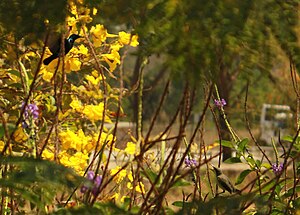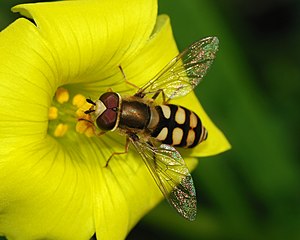
Back زراعة تجديدية Arabic Agricultura regenerativa Catalan Regenerativní zemědělství Czech Regenerative Landwirtschaft German Agricultura regenerativa Spanish Taastav põllumajandus Estonian Uudistava maatalous Finnish Agriculture régénératrice French Regenerativna poljoprivreda Croatian Talajmegújító mezőgazdaság Hungarian

Regenerative agriculture is a conservation and rehabilitation approach to food and farming systems. It focuses on topsoil regeneration, increasing biodiversity,[1] improving the water cycle,[2] enhancing ecosystem services, supporting biosequestration,[3] increasing resilience to climate change, and strengthening the health and vitality of farm soil.
Regenerative agriculture is not a specific practice. It combines a variety of sustainable agriculture techniques.[4] Practices include maximal recycling of farm waste and adding composted material from non-farm sources.[5][6][7][8] Regenerative agriculture on small farms and gardens is based on permaculture, agroecology, agroforestry, restoration ecology, keyline design, and holistic management. Large farms are also increasingly adopting regenerative techniques, using "no-till" and/or "reduced till" practices.
As soil health improves, input requirements may decrease, and crop yields may increase as soils are more resilient to extreme weather and harbor fewer pests and pathogens.[9]
Regenerative agriculture mitigates climate change through carbon dioxide removal from the atmosphere and sequestration. Along with reduction of carbon emissions, carbon sequestration is gaining popularity in agriculture, and individuals as well as groups are taking action to fight climate change.[10]

- ^ "Our Sustainable Future - Regenerative Ag Description". csuchico.edu. Retrieved 2017-03-09.
- ^ Underground, The Carbon; Initiative, Regenerative Agriculture; CSU (2017-02-24). "What is Regenerative Agriculture?". Regeneration International. Retrieved 2017-03-09.
- ^ Teague, W. R.; Apfelbaum, S.; Lal, R.; Kreuter, U. P.; Rowntree, J.; Davies, C. A.; Conser, R.; Rasmussen, M.; Hatfield, J.; Wang, T.; Wang, F. (2016-03-01). "The role of ruminants in reducing agriculture's carbon footprint in North America". Journal of Soil and Water Conservation. 71 (2): 156–164. doi:10.2489/jswc.71.2.156. ISSN 0022-4561.
- ^ Schreefel, L.; Schulte, R.P.O.; De Boer, I.J.M.; Schrijver, A. Pas; Van Zanten, H.H.E. (2020-09-01). "Regenerative agriculture – the soil is the base". Global Food Security. 26: 100404. doi:10.1016/j.gfs.2020.100404. ISSN 2211-9124.
- ^ "Regenerative Agriculture". regenerativeagriculturedefinition.com. Retrieved 2017-03-07.
- ^ "Regenerative Agriculture". Regenerative Agriculture Foundation. Retrieved 2017-03-09.
- ^ "Definition — The Carbon Underground : The Carbon Underground". thecarbonunderground.org. Retrieved 2017-03-07.
- ^ "Regenerative Organic Agriculture | ORGANIC INDIA". us.organicindia.com. Retrieved 2017-03-09.
- ^ Moebius-Clune, B. N. (2016). "Comprehensive Assessment of Soil Health – The Cornell Framework (Version 3.2)". Cornell University, Cornell Soil Health Laboratory (Edition 3.2 ed.). Retrieved 2021-04-17.
- ^ Perroni, Eva. "18 Organizations Promoting Regenerative Agriculture Around the Globe". Food Tank. Food Tank. Retrieved 8 October 2023.
© MMXXIII Rich X Search. We shall prevail. All rights reserved. Rich X Search